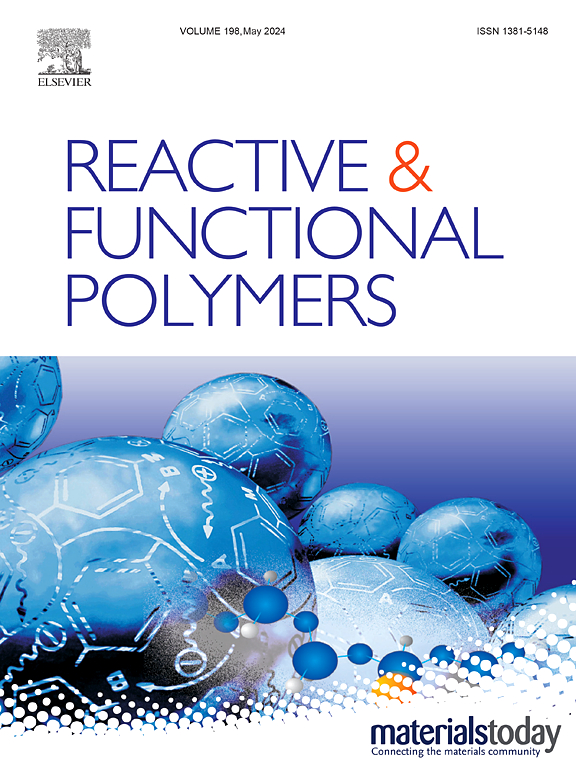Molecularly imprinted polymer systems for the controlled release of naphthoquinone derivatives with antimicrobial activity
IF 5.1
3区 工程技术
Q1 CHEMISTRY, APPLIED
引用次数: 0
Abstract
This study aimed to synthesize, characterize, and evaluate molecularly imprinted polymers (MIPs) as drug delivery systems for naphthoquinone (NQ) derivatives. MIPs were synthesized using non-covalent bulk and co-precipitation polymerization methods, employing lactic acid (LA) and methacrylic acid (MA) as functional monomers and ethylene glycol dimethacrylate as a crosslinker. The quantification of 3-chloro-2-tyrosine-1,4-naphthoquinone (Cl-NQ-TYR) and 2-tyrosine-1,4-naphthoquinone (NQ-TYR) was performed using liquid chromatography with a diode array detector. The method demonstrated excellent linearity (R2 = 0.99) within the working range (0.5–10 mg L−1) and acceptable precision, with intra-day (CV: 0.62–2.14 % and 1–4.27 %) and inter-day (CV: 0.18–1.76 % and 0.62–5.46 %) variation for Cl-NQ-TYR and NQ-TYR, respectively. MIPs synthesized with MA exhibited the highest retention rates (99.53 % and 98.58 %). Electrostatic interactions influenced drug release properties, with zero charge points of 3.8 and 4.7, indicating that polymer ionization at higher pH values enhances drug release. All MIPs achieved imprinting factors above one (1.18–1.89), indicating that the molecular imprinting process was successful. The release profile showed an initial burst followed by sustained release over 24 h, with Cl-NQ-TYR MIP (MA, bulk) exhibiting the highest release rate, fitting best with the Korsmeyer-Peppas model. Antimicrobial activity against Escherichia coli (minimum inhibitory concentration, MIC: 12.5 μg mL −1) and Staphylococcus aureus (MIC: 3.12 μg mL−1) was attributed to released NQ derivatives. MIPs demonstrated biocompatibility with dermal fibroblasts, highlighting their suitability for medical applications. These results position MIPs as a promising platform for the safe and effective delivery of therapeutic agents in biomedical applications.

具有抗菌活性的萘醌衍生物的分子印迹聚合物控制释放系统
本研究旨在合成、表征和评价分子印迹聚合物(MIPs)作为萘醌(NQ)衍生物的给药系统。以乳酸(LA)和甲基丙烯酸(MA)为功能单体,乙二醇二甲基丙烯酸酯为交联剂,采用非共价本体聚合和共沉淀聚合法制备了MIPs。3-氯-2-酪氨酸-1,4-萘醌(Cl-NQ-TYR)和2-酪氨酸-1,4-萘醌(NQ-TYR)采用二极管阵列检测器液相色谱法进行定量分析。该方法在工作范围(0.5 ~ 10 mg L−1)内线性良好(R2 = 0.99),精密度可接受,日间(CV: 0.62 ~ 2.14%和1 ~ 4.27%)和日间(CV: 0.18 ~ 1.76%和0.62 ~ 5.46%)变化。用MA合成的MIPs保留率最高,分别为99.53%和98.58%。静电相互作用影响药物的释放特性,零电荷点为3.8和4.7,表明在较高pH值下聚合物电离促进药物释放。印迹因子均在1以上(1.18-1.89),表明印迹过程成功。释放曲线表现为初始爆发,随后持续释放24 h,其中Cl-NQ-TYR MIP (MA, bulk)的释放速率最高,最符合Korsmeyer-Peppas模型。NQ衍生物对大肠杆菌(最低抑菌浓度,MIC: 12.5 μg mL−1)和金黄色葡萄球菌(MIC: 3.12 μg mL−1)具有抑菌活性。MIPs表现出与真皮成纤维细胞的生物相容性,突出了其在医学应用上的适用性。这些结果使MIPs成为生物医学应用中安全有效地递送治疗剂的有前途的平台。
本文章由计算机程序翻译,如有差异,请以英文原文为准。
求助全文
约1分钟内获得全文
求助全文
来源期刊

Reactive & Functional Polymers
工程技术-高分子科学
CiteScore
8.90
自引率
5.90%
发文量
259
审稿时长
27 days
期刊介绍:
Reactive & Functional Polymers provides a forum to disseminate original ideas, concepts and developments in the science and technology of polymers with functional groups, which impart specific chemical reactivity or physical, chemical, structural, biological, and pharmacological functionality. The scope covers organic polymers, acting for instance as reagents, catalysts, templates, ion-exchangers, selective sorbents, chelating or antimicrobial agents, drug carriers, sensors, membranes, and hydrogels. This also includes reactive cross-linkable prepolymers and high-performance thermosetting polymers, natural or degradable polymers, conducting polymers, and porous polymers.
Original research articles must contain thorough molecular and material characterization data on synthesis of the above polymers in combination with their applications. Applications include but are not limited to catalysis, water or effluent treatment, separations and recovery, electronics and information storage, energy conversion, encapsulation, or adhesion.
 求助内容:
求助内容: 应助结果提醒方式:
应助结果提醒方式:


